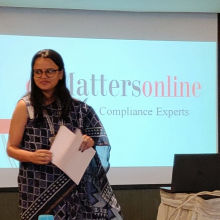Company non-operational? Reduce your compliance burden

சட்ட மற்றும் இணங்குதல்
288 வாரத்திற்கு முன்பு — 10 நிமிடம் படிக்க
Background: Acquiring a ‘dormant’ status is beneficial for companies that are not operational as it reduces compliance costs. In her previous article, Priyanka Srivastava, Founder-CEO of Camattersonline shared the key takeaways from the Angel Tax proposal. In this article she list all the details related to the process of acquiring ‘dormant’ status for a non-operational business..
Section-455 of Companies Act, 2013 has introduced the concept of “Dormant Company” or "Asset Shielding Concept". A Dormant Company offers excellent advantages to promoters who want to hold an asset or intellectual property under the corporate shield for its usage at a later stage.
Certain companies, due to the nature of their business, may not be able to start any business, for a long time from the date of incorporation or have no significant accounting transactions. This concept is useful for construction companies or real estate companies which incorporate new companies to hold land for future projects. If a company gets status of dormant company, there are less compliances to be followed. Hence it helps in saving cost of compliance for inactive companies.
Also read: Key elements of a non-disclosure agreement
A dormant company can also prove useful when an individual wishes to stop trading for a specific period of time. For example, if an individual has been running a successful company but wishes to move abroad, they can choose to preserve his company so that they can restart operations at a later date.
A dormant company may be either a public company or a private company or a one person company.
Key definitions to understand the scope of this concept better
Inactive company
An Inactive Company means a company which,
- Has not been carrying any business or operation; or
- Has not made any significant accounting transaction during the last two financial years;
- Has not filed financial statements and annual returns during the last two financial years
Significant Accounting Transaction
Significant Accounting Transaction means any transaction other than:
- Payment of Fees by a company to the Registrar;
- Payments made by it to fulfill the requirements of this Act or any other law;
- Allotment of shares to fulfill the requirements of this Act; and
- Payments for maintenance of its office and records.
Financial Statement
The term ‘financial statement’ as per section 2(40) means:
- Balance sheet at the end of financial year;
- Profit and Loss Account or Income or Expenditure account, as may be applicable;
- Cash flow for the financial year; and
- Explanatory note attached to any document in sub-clause (i) or (ii) above.
Also read: 10 things entrepreneurs should know about patents
Before applying for status of Dormant Company, following conditions should be fulfilled:
- No inspection, inquiry or investigation has been ordered or taken up or carried out against the company;
- The company is neither having any public deposits which are outstanding nor is the company in default in payment thereof or interest thereon;
- No prosecution has been initiated or pending against the company under any law;
- The company has not defaulted in the payment of workmen's dues;
- The company does not have any outstanding statutory taxes, dues, duties etc. payable to the Central Government or any State Government or local authorities etc.;
- The application has not been made with an objective to deceive the creditors or to defraud any other person;
- The securities of the company are not listed on any stock exchange within or outside India;
- The company is not having any outstanding loan, whether secured and unsecured. But if company has any outstanding unsecured loan then the company may apply for status of dormant only after obtaining NOC from the lender. Such NOC is required to be attached in the Form which must be filed with ROC.
- There is no dispute in the management or ownership of the company. A certificate in this regard required to taken from management. Such certificate is required to be attached in the Form which must be filed with ROC.
Process for obtaining status of dormant company
1. Call a Board Meeting to organise EGM
Authorization to director to make application for Dormant with ROC.
Issue Notice of General Meeting.
Engage an Auditor/ Chartered Accountant to issue certificate.
2. Hold Extra Ordinary General Meeting to pass special resolution.
3. File E-form MGT-14 with ROC.
Attachment: CTC of Special Resolution, Notice of EGM along with explanatory statement.
4. After filling of form MGT-14, File Form MCS-1 with the registrar.
Attachments:
- CTC of Board Resolution
- CTC of Special Resolution
- Auditor's Certificate
- Statement of Affairs duly certified by Chartered Accountant or Auditor(s) of the company
- Latest financial statement and annual return of the company is mandatory to attach In Case The same is filed to Registrar
- Certificate regarding no dispute in the management or ownership
- Consent of lender, if any loan is outstanding
Processing sequence
The eForm will be auto approved (STP).
Email: When an eForm is approved/ rejected by the authority concerned, an acknowledgement of approval/rejection with related documents is sent to the user in the form of an email to the email id of the company.
Certificate: A system generated certificate of status of a Dormant Company is issued by Registrar and sent to the user as an attachment to the email, after approval is granted. Once the form is approved the status of the company shall be changed to ‘Dormant under section 455'.
Forms required to be filed with ROC after status of dormant
After getting certificate of Dormant Company, a company has to file the following forms with ROC:
- A dormant company shall file a declaration annually in Form No. MSC-3 within 30 days from the end of each financial year.
- Company shall continue to file the return or returns of allotment and change in directors in the manner and within the time specified in the Act, whenever the company allots any security to any person or there is any change in the directors of the company.
- If company wants to get Active status, it has to file e-form MSC-4 with ROC
- If company conducts any significant transaction during the dormant period, the directors shall within 7 days from such event, file an application with ROC in e-form MSC-4, for obtaining the status of an active company
- The company may carry following business transaction in the period of Dormancy:
-Payment of fees by a company to the Registrar;
-Payments made by it to fulfill the requirements of this Act or any other Law;
-Allotment of shares to fulfill the requirements of this Act; and
-Payments for maintenance of its office and records.
Dormant Companies are also exempted from the following
- To include cash flow statements in their financial statements.
- From holding board meeting in each quarter. Dormant companies are required to hold board meeting in each half of the calendar year with a gap of at least 90 days. Therefore, dormant companies are required to hold only two board meetings mandatorily during the year.
- The provisions of the Act in relation to the rotation of auditors shall not apply to dormant companies.
Compliances by a dormant company
- Minimum number of directors for dormant company: A dormant company shall have a minimum number of three directors in case of a public company, two directors in case of a private company and one director in case of a One Person Company.
- Return of dormant companies: A dormant company shall file a Return of Dormant Company annually, indicating financial position duly audited by a chartered accountant in practice in Form MSC-3 along with such annual fee as provided in the Companies (Registration Offices and Fees) Rules, 2014 within a period of thirty days from the end of each financial year.
- Provided that the company shall continue to file the return or returns of allotment and change in directors in the manner and within the time specified in the Act, whenever the company allots any security to any person or there is any change in the directors of the company.
Notes:
The Registrar on its own motion can also change the status of a company to dormant if it has not filed financial statements or annual returns for two financial years consecutively. The Registrar will do so only after giving the company a reasonable opportunity of being heard.
Proviso to Rule 8 of the Companies (Miscellaneous) Rules, 2014 says that a dormant company cannot remain as a dormant company for more than 5 consecutive financial years. If it remains so, then the Registrar shall commence the process of striking off the name of the company from the Records, i.e. the company will be removed. So maximum tenure for a dormant company is 5 consecutive financial years.
Also read: Mandatory compliances for a Private Limited Company in India
Image courtesy: shutterstock.com
To explore business opportunities, link with me by clicking on the 'Connect' button on my eBiz Card.
பதிவிட்டவர்
Priyanka SrivastavaFounder and Owner of caMattersOnline, one of the fastest growing organization in the Finance and Accounting space in the Industry. caMattersOnline offers compliance service...
இந்த கட்டுரையில் குறிப்பிட்டுள்ள SME களுடன் பிணையம்
Priyanka இன் சுயவிவரத்தை காண்க
Priyanka Srivastava எழுதப்பட்ட பிற கட்டுரைகள்
Key takeaways from the Angel Tax proposal
296 வாரத்திற்கு முன்பு
இந்த வாரம் அதிகம் படித்தது
டிரெண்டிங்
சிறு மற்றும் நடுத்தர நிறுவனங்கள் (SME) டிஜிட்டல் மயமாக்கல் மூலம் வெற்றிக்கான புதிய பாதை
Digital & Technology 8 வாரத்திற்கு முன்பு
Learning & Development 21 வாரத்திற்கு முன்பு
Top Exports from India to Sri Lanka: A Detailed Analysis of Leading Products
Export Sector 22 வாரத்திற்கு முன்பு











கருத்துகள் (1)
தயவு செய்து உள்நுழைய அல்லது பதிவு விவாதத்தில் சேர